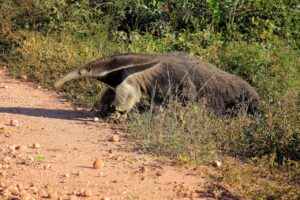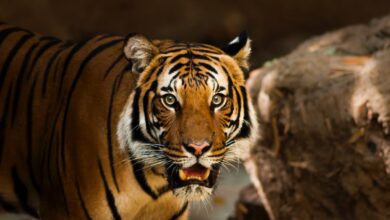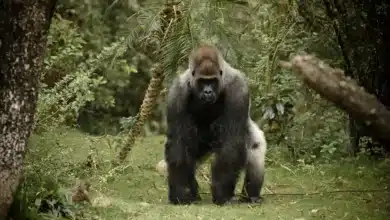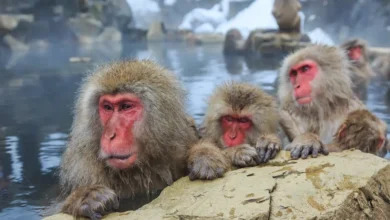19 Interesting Facts About The Giant Anteater
The giant anteater, scientifically known as Myrmecophaga tridactyla, is a unique and fascinating creature found in the wilds of Central and South America.
With its long snout, distinct appearance, and impressive hunting skills, this mammal stands out among its counterparts. In this article, we will explore 19 interesting facts about the giant anteater.
1. Overall Appearance
The giant anteater can grow up to an impressive length of seven feet from nose to tail and weigh between 60 to 100 pounds.
It has a slender body covered with thick fur that ranges from grayish-brown to black. Moreover, it boasts large claws on its forelimbs that aid in digging anthills.
2. Feeding Behavior
As their name suggests, these remarkable creatures primarily feed on ants and termites courtesy of their elongated snouts and sticky tongues that can reach up to two feet in length.
Each day they consume around 30,000 insects by using their specialized tongue to lick them up from anthills.
3. Unique Tongue Adaptation
Giant anteaters have evolved an impressive tongue adaptation for efficient feeding: their tongue secretes sticky saliva that traps insects during slurping motions inside anthills or termite mounds, much like eating with a built-in vacuum cleaner.
4. Digestive System
To cope with such high insect intake daily, these mammals possess peculiar digestive systems consisting of enlarged salivary glands as well as an extended stomach which aids in breaking down the tough exoskeletons of ants efficiently.
5. Social Structure
While most solitary creatures struggle with loneliness—giant anteaters are truly social beings! They typically live alone but may occasionally gather in small groups called “concentrations.”
Despite this behavior though, conflicts between individuals are rare as they generally prefer peaceful interactions.
6. Nocturnal Behavior
Giant anteaters are predominantly nocturnal! Owing to their sensitive hearing and powerful sense of smell, these creatures have adapted to a night-hunting lifestyle.
They spend the majority of daylight hours in simple leaf nests on the ground, only venturing out during cooler nights.
7. Habitat Preferences
These incredible mammals can be found inhabiting a variety of environments, including grasslands, savanna’s, and humid forests throughout Central and South America.
Due to deforestation and habitat loss, they are becoming increasingly threatened in the wild.
8. Good Climbers
You may wonder if a creature with such long claws is capable of climbing trees. Surprisingly, giant anteaters are not adept climbers. Instead, they rely on their strong forelimbs and sharp claws for digging into anthills or termite mounds rather than navigating tree branches.
9. Predators
Despite their size, giant anteaters have natural predators in the wild. Jaguars and cougars pose a threat to these creatures, especially the young ones, who are more vulnerable due to their size and lack of experience.
10. Lifespan
Giant anteaters have an average lifespan of 10-15 years in the wild. However, they can live up to 25 years under human care in captivity, where they receive dedicated nutrition and medical attention.
11. Reproduction
The mating rituals of giant anteaters involve elaborate dances between males and females before copulation occurs.
After a gestation period of about six months, female giant anteaters give birth to one offspring at a time—something quite rare among mammals that typically give birth to multiple young at once.
12. Unique Vocalizations
While some animals communicate through complex calls or songs, giant anteaters have simpler vocalizations consisting mainly of hissing sounds when threatened or surprised by humans or other potential threats.
13. Endangered Status
Due to deforestation, habitat loss, and increasing human activities within their range, giant anteaters face significant challenges for survival in the wild today. As a result, they are classified as “Vulnerable” on the IUCN Red List of Threatened Species.
14. Conservation Efforts
Understanding the importance of protecting these remarkable creatures is crucial for conservation efforts worldwide! Many organizations work tirelessly towards raising awareness about habitat preservation as well as preventing illegal hunting practices that further endanger this species’ existence.
15. Slow Metabolism and Energy Conservation
The giant anteater has an incredibly slow metabolic rate, which enables it to conserve energy and survive on its relatively low-calorie diet of ants and termites. They can go up to two weeks without eating, thanks to their efficient metabolism and specialized adaptations for extracting nutrients from insects.
Their low-energy lifestyle is further supported by their habit of spending long periods resting during the day. By minimizing their activity levels, they conserve energy for hunting during cooler nighttime conditions when ant activity peaks.
16. Longevity in Antics
While most mammals may tire easily or become bored with repetitive actions, this isn’t the case for the giant anteaters! Their appetite for ants seems insatiable, as they can spend hours upon hours probing anthills or termite mounds without losing interest.
With its claws acting as powerful excavation tools, the giant anteater meticulously tears apart insect nests to reach its prey using a backward-and-forward motion with its snout. This behavior allows them to consume thousands of insects per sitting with ease.
17. Efficient Travelers
Despite being built for ground movements rather than speed, these creatures are surprisingly efficient travelers across vast territories in search of food sources. The giant anteater can cover extensive distances—up to nine miles a day—while exploring different areas in its habitat!
To facilitate efficient travel on land, they use stiff bristles on their hind legs as well as rolling motions while walking—a behavior that minimizes energy expenditure and prevents fatigue over long journeys.
18. Unique Role against Forest Fires
Believe it or not, giant anteaters have an unexpected but crucial role in mitigating forest fires! In regions where wildfires occur naturally or due to human activities such as slash-and-burn agriculture practices, these creatures actively feed on escaped ants fleeing from burning nests.
By doing so, they inadvertently contribute to controlling the spread of fire by limiting the mobility and survival rates of these insects. It’s a fact that highlights the interconnectedness between species in maintaining ecosystem balance.
19. Vocalizations and Communication
While giant anteaters are not known for their complex vocalizations, they do communicate through various sounds to convey messages or establish territory boundaries.
Amidst their mostly silent nature, they occasionally emit a series of non-aggressive clicking noises as well as growls when threatened or during interactions with other members of their species.
These vocal expressions serve as unique identifiers among individuals and also play a critical role in maintaining social interactions within the giant anteater community. However, it is important to note that their vocal repertoire is limited compared to other mammal species.
Conclusion
The giant anteater may be modestly named, but it’s clearly got something special going on, both in the way it looks and how it acts.
It’s a unique mammal with fascinating attributes—from its incredible feeding adaptations to its social behavior and conservation status.
The giant anteater truly captures our imagination, reminding us of the wonders that exist within the animal kingdom and the responsibility we have in preserving them for future generations.
So if you ever find yourself wandering through Central or South America, keep an eye out for this enigmatic creature.
Seeing a giant anteater in action is not only a rare treat but also serves as a reminder of the intricate web of life that surrounds us and the importance of protecting our natural habitats.
By understanding and appreciating these 19 facts about the giant anteater, we can foster a greater appreciation for this unique species and work towards ensuring its long-term survival.




